Archive for ‘General’ Category
Reference Files Master Class (Part 3) — Medical Papers
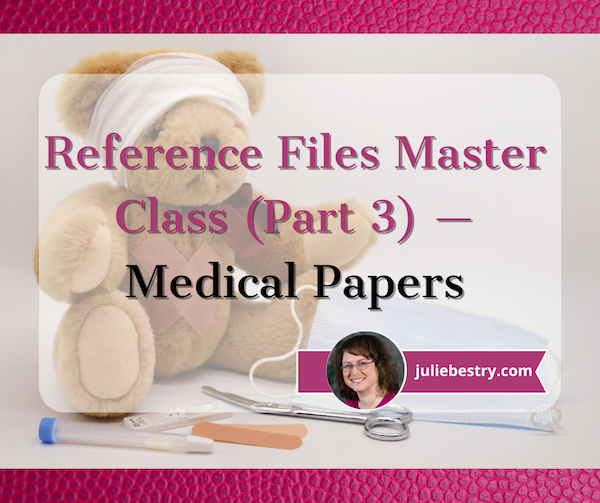
For our final post of Get Organized & Be Productive (GO) Month, we’re continuing our refresh of classic posts and essential concepts in paper organizing. So far, we’ve looked at:
Paper Doll Shares 12 Kinds of Paper To Declutter Now
Reference Files Master Class (Part 1) — The Essentials of Paper Filing
Reference Files Master Class (Part 2) — Financial and Legal Papers
Today, we continue onward with the next element of the reference papers in your personal or family filing system.
- Financial
- Legal
- Medical
- Household
- Personal
MEDICAL FILES
There’s a special name the information you maintain about your medical life: a personal health record (PHR). With the financial and legal documents we covered last week, I strongly recommended using to develop your file management skills; however, you’ll see that with medical information, I recommend a hybrid approach with paper and sometimes a digital one.
Your Role as Personal/Family Medical Historian
You may wonder why you might need to keep medical paperwork of any kind. After all, don’t the doctors all have your files? It’s not like the average person has a collection of all their own dental X-rays and test results laying around. But there are certain reasons you should keep at least some of your medical information, if not your actual records. For example:
- When you go to a new health care provider or visit the hospital, you will be asked for a detailed medical history. Will you really remember the years and types of all of your (or your family members’) illnesses, surgeries, and complications? Which physicians were seen and what their contact information was? Which medications caused allergic reactions? It’s your job to provide that information.
- If you change health insurance companies or apply for life insurance, you’ll have to provide a detailed medical history. If you are found to have given even the teeniest of wrong answers, your policy could be voided retroactively and you could be on the hook for hundreds of thousands of dollars of healthcare!
- First responders may need information in a hurry. This is why you need to keep updated copies of your medication lists (medication names, dosages, prescribing physicians) in multiple places, immediately accessible. (See Organize to Help First Responders: The Vial Of Life for details on this specific issue.)
- Quick access to accurate information may determine a medical course of action. For example, if your college student calls to say they had a minor accident and the student health center wants to know how long ago they had a tetanus booster, don’t you want to give the right answer? (Better yet, arm your adult kids with copies of their records so they’ll know!)

Doctor With Stethascope Photo by Online Marketing impulsq on Unsplash
- If you’re in the ER or at Urgent Care and are asked a question about your medical history, you can’t rely on your primary care physician’s records. The doctor’s staff may be unreachable on weekends and holidays, or in the evenings, or on inclement weather days.
- Your physician or dentist may retire with little notice, giving you no chance to get copies of records. (I’ve had three doctors and a dentist retire in the last 5 years. Yes, I’m starting to take it personally!)
- If you can prove you’ve already been tested for certain things, you may be able to avoid unnecessary (and expensive) medical tests.
- If you have proof of immunizations, you can make sure you’re protected against all sorts of yuckies without having duplicate ouchies! (Yes, these are the correct medical terms.) Proof also ensures that your children can attend school or go to summer camp. (You do not want to spend the days prior to driving cross-country to your student’s new campus rushing to find a physician who will squeeze your 18-year-old in for shots.)
- Speaking of immunizations, if you ever work or vacation outside North America, you may need proof of health and immunization for travel; you don’t want to have to contact your doctor over and over and be beholden to their convenience and schedules. (For more, check the CDC’s Yellow Book on Traveler’s Health.)
Additionally, you may be responsible for making decisions or overseeing care for someone else. This might be your child or your spouse, where you can rely on your memory. But what if you’re involved in the care of an elderly and/or ailing relative? Wouldn’t you prefer they had this information organized and available to you?
And what if you’re the one who is ill and needing someone to advocate for your medical well-being? While it’s important for your healthcare proxy (the person with your medical Power of Attorney) to have access to the full picture, sometimes it’s just helpful for your loved ones to be able to provide educated input when you are feeling woozy or distressed.
Methods for Organizing Medical Information
To start, create a hanging folder for each person in the household. How many internal folders you’ll need for each person depends on how much information pertains to each individual.
One folder may suffice for younger, healthier individuals with limited records. However, my clients often use three — one for medical information, one for dental information (often including extensive orthodontia plans), and one for vision (to track vision changes and safely keep eyeglass or contact lens prescriptions until needed). If anyone in the family has a specific, ongoing medical condition (diabetes, arthritis, etc.) add extra interior folders as needed so you can track specialized medical information.
There are other auxiliary methods for maintaining medical records:
- 3-ring binders — If you or someone in your family has a complicated medical situation, a chronic illness, or is undergoing cancer treatment or dialysis, and is visiting many doctors and hospitals, often having to supply information repeatedly, a sectioned-three ring binder for mobile use may make it easier for you to take notes or have providers make copies of your information. Consider this an adjunct to your paper file system, with sections for appointment dates, notes, special instructions, and test results.
- Medical Organizer — If you are in college or newly graduated, your filing space in a dorm or small apartment may be limited. To get you started, you may want to use a something like the multi-pocked Smead All-in-One Healthcare and Wellness Organizer.
Reference Files Master Class (Part 1) — The Essentials of Paper Filing
COPING WITH PAPER OVERWHELM
After last week’s post, Paper Doll Shares 12 Kinds of Paper To Declutter Now, I had a number of readers mention to me that while knowing what to get rid of helps them deal with their paper piles, they were still sometimes at a loss as to what to do with the rest.
Some fear they should be scanning everything to keep it digital, but don’t even own scanners. Others feel frustrated because even when they’ve arranged to get (and pay) their bills digitally, they still have paper coming to them. Many people feel at odds with the 21st-century pressure to have digital records, and don’t particularly feel adept with handling papers digitally. (They forget to look at email until it’s too late, or they never get around to scanning, or information just doesn’t seem “real” to them if it’s not in tangible form).
Over the 16+ years that I’ve been blogging as Paper Doll, I’ve tried to get across that whether you use analog or digital techniques — whether for paying bills, or keeping track of your appointments and tasks, or filing or archiving your information — doesn’t matter. That is, the method doesn’t matter; the commitment to a system is what is most important.
But 16 years is a long time. Babies born during the launch of my first Paper Doll posts are old enough to drive! To give you a sense of how long ago that was, Desperate Housewives was still a top-10 TV show (and people were still watching broadcast television). The top song was Crank That (Soulja Boy) and we were all trying (and mostly failing) to do the dance.
I originally wrote about the elements of a reference filing system in the first month of Paper Doll posts, back in 2007. It’s time to revisit the topic, see how digital solutions do (and don’t) help with the paper overwhelm, and introduce new readers to the best ways to manage paper.
Over the next several weeks, we’ll be taking a fresh look at how eliminate the frustration of paper files.
The Ice Cream Rule
The key to making any system work is just that — a system. That means having a location where something belongs and behavioral rules to get them there. I often refer to this as the Ice Cream Rule. If you come home from the store with two bags, one holding a half gallon of cream and one with a package of toilet paper, which one will you put away first? And where would you put them?
Even people who insist that they’re terrible with systems laugh and admit that they automatically know to put the ice cream away first; they recognize that they’ll end up with a melted mess if they do not.
They also have no worries that they’ll put the ice cream where they won’t be able to find it again — in the cupboard or the pantry — because their system not only includes behavioral cues (ice cream before toilet paper), but a geographic location (that is, the freezer) where the ice cream belongs.
Yes, people may drop the bag with the toilet paper on the kitchen floor, or hang it on the linen closet door, or actually put away the toilet paper in the bathroom right after getting the ice cream in the freezer.
Admittedly, the behavioral part of putting away non-urgent items isn’t perfect. The squeaky wheel gets the oil, and when it comes to putting things away properly, ice cream’s urgency is squeakier than toilet paper. (That said, the retrieval of ice cream is likely to be less urgent.)
A HOME FOR YOUR REFERENCE FILING SYSTEM
The point, and I do have one, is that to create order with the paper in our lives, we must ensure that we know exactly where everything goes. How? Filing papers is easy once each item is assigned a place to live. All of your reference papers need to have a home.
Keep in mind, that home does not have to be a palace. You certainly can invest in filing cabinets. These range from bargain 2-drawer metal filing cabinets to office-style 4-drawer tower-style cabinets.
If you prefer lateral filing cabinets (where you stand to the side of the open drawer, rather than in front of it), there are a variety of styles and materials from which to choose.
Recapping Paper Doll’s 2023 Posts — Which Were Your Favorites?

With one week left in 2023, have you taken time yet to review your year?
For the December Productivity and Organizing Blog Carnival, Janet Barclay asked us to identify our best blog posts of 2023, and I had a tough time.
“Best” is subjective, and Janet let us have free reign as to which post fit. Some bloggers chose their most popular posts in terms of readership; others, the ones that garnered the most comments. Some of my blogging colleagues picked their most personal posts, while others selected what they felt would have the most impact on people’s lives.
The problem is that picking just one means leaving the others behind, and I wrote forty-two posts this year! Eventually, I narrowed the selection to half a dozen posts, and then turned to colleagues and friends who were almost evenly split, bringing me no closer to a solution. In the end, I picked Paper Doll On Understanding and Conquering Procrastination because it served as the foundation for so many other posts, but also because I’d been lucky enough to find some great visuals, like this one from Poorly Drawn Lines:
so much to do pic.twitter.com/fiSm7Y2Erg
— poorly drawn lines (@PDLComics) December 21, 2022
Beauty, like clutter, is in the eye of the beholder. To that end, here’s a recap of everything we’ve discussed in 2023, with a few updates and tweaks along the way. My personal favorites are in bold, but I’d love to know which ones resonated the most with you during the year!
ORGANIZE YOUR INSPIRATION
After uploading last week’s post, Toss Old Socks, Pack Away 2023, and Adjust Your Attitude for 2024, I got to thinking about all the different ways we can take our word, phrase, or song of the year and keep it in the forefront of our minds.
I’d reviewed the traditional methods (vision boards, posted signs, turning the song into your wakeup alarm), but felt like there needed to be something that stayed with you, independent of your location. Only being reminded of your goal to be a leader when you’re standing in front of your fridge doesn’t really help you in your 1-to-1 meetings at work. (I mean, unless you’re the Queen of the Condiments or King of the Crisper Drawer.)
Only being reminded of your goal to be a leader when you're standing in front of your fridge doesn't really help you in your 1-to-1 meetings at work. (I mean, unless you're the Queen of the Condiments or King of the Crisper Drawer.) Click To TweetSerendipitously, within minutes of thinking about this, an ad came across one of my social media pages. (Normally, I ignore ads, but this one had me thinking maybe “serendipity” would be a good theme word for some year!) The ad was for Conscious Ink, an online temporary tattoo retailer specifically for creating body art to help you mindfully connect with your themes and messages to yourself, disrupt negative self-talk, and promote the healthy habits you’re trying to embrace!
As Conscious Ink’s About page explains, if you want to keep something top of the mind, why not try something that keeps it “top of the body?” Whether body art is your thing or you haven’t experimented since your Minnie Mouse temporary tattoo at summer camp <mumble mumble> years ago, this is a neat trick!
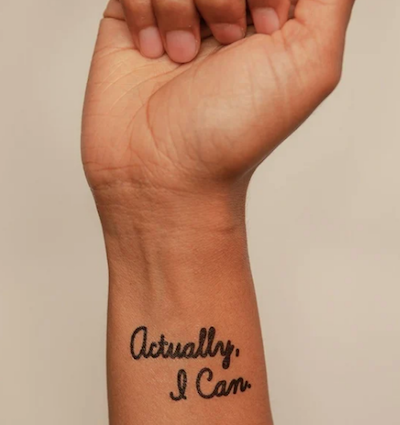
There’s even research as to how a temporary tattoo can support permanent emotional and cognitive transformation and improve mindfulness and focus on things that uplift one’s higher self. And that’s the point of a theme word, phrase, or song, to keep you focused on what you want rather than what you allow to drag you down! Manifest what you want your life to be.
Conscious Ink’s temporary tattoos use non-toxic, cosmetic-grade, FDA-certified, vegan inks. Each one lasts 3-7 days, depending on where you apply it, your skin type and activity level, and (I suspect) how many life-affirming, stress-reducing bubble baths you take. Categories include mindset, health and wellness, spiritual/nature, relationships, parenting, celebratory, and those related to social causes. Prices seem to hover at around $10 for a three-pack and $25 for a 10-pack. There’s even a Good Karma Guarantee to make sure you’re satisfied.
Whether you go with Conscious Ink (which is designed for this uplifting purpose) or seek an alternative or custom-designed temporary tattoo (through vendors like Momentary Ink or independent Etsy shops), it only makes sense if you place it somewhere you can see it often.
After all, if you place a temporary tattoo reminder to stand up for yourself on your tushy, it probably won’t remind you of much. For most of us of a certain age, putting it at our wrists, covered (when we prefer) by our cuffs, will give us the most serene “om” for our buck.
If you place a temporary tattoo reminder to stand up for yourself on your tushy, it probably won't remind you of much. Click To TweetAlong the same lines as my advice on adjusting your attitude for 2024, you may want to consult Gretchen Rubin’s Tips for Your “24 for 2024” List. Rubin and her sister/podcast co-host always have an inspring Happier Trifecta: a year-numbered theme, along with with a challenge and a list.
PRODUCTIVITY AND TIME MANAGEMENT
This was a big year for productivity discussion. I’m a firm believer that keeping your space and resources organized is key to being productive. However, it’s hard to keep the world around you organized when outside influences prevent you from being efficient (doing things well) and effective (doing the right things).
We continue to see the value of body doubling, whether through friendly hang-outs, co-working (virtually or in person), or professional organizing services, whether you want to conquer garden-variety procrastination or get special support for ADHD.
Partnering for Success
Paper Doll Sees Double: Body Doubling for Productivity (I almost submitted this post to the carnival. Accountability and motivation for the win!)
Paper Doll Shares 8 Virtual Co-Working Sites to AmpUp Your Productivity
If you’d like to explore the body doubling or co-working experience, friend-of-the-blog Deb Lee of D. Allison Lee is offering a no-cost, two-hour Action Day event on Tuesday, January 9, 2024, from 10 a.m. to 12 p.m.

This event is designed for her clients and subscribers, but after a cheery holiday conversation, Deb said it was OK to let my readers know about the opportunity.
Deb describes an Action Day as “personal training for your productivity muscles!”
An Action Day (especially as Deb runs them) is a stellar way to narrow your focus and start taking action on your goals. (And what better time than at the start of the new year?) You’ll get to connect with others who are also working on goals and habits with the support of Deb, a productivity coach I admire and adore.
Just bring your top two or three priorities, and you can conquer anything, like:
- organize your workspace
- write your book outline
- clean up your digital files
- test a new productivity app
- send out client proposals
- anything!
You’ll videoconference with a small, select group via Zoom. Share your goal and tasks, work for the bulk of the two hours, and then take time to debrief and share your successes!

Moving Yourself Forward
Getting anything done involves figuring out what you have to do, knowing what’s kept you from getting started, making it easy for you to begin, and celebrating even the smallest wins. These next three posts were where the magic happened this year!
Paper Doll On Understanding and Conquering Procrastination (This is the post I submitted to the Productivity & Organizing Carnival.)
Frogs, Tomatoes, and Bees: Time Techniques to Get Things Done
Use the Rule of 3 to Improve Your Productivity
Dealing with the Pokey Times
If you’re overwhelmed by all you’ve got going on during late December and early January, you can skip onward. However, if your workplace closes down during the holidays, or your professional and personal lives just feel like they’re kind of in a slump right now, you may find some inspiration in two pieces I wrote for the summer slowdown.
The weather outside may be frightful (unless you’re reading from Australia), but if you are looking for ideas to pump you up when everyone is in a post-shopping/meal/travel haze, these posts may stir your motivation:
Organize Your Summer So It Doesn’t Disappear So Quickly
Use Your Heart, Head, and Hands to Organize During the Slow Times
Try To Do It All (And Knowing When to Step Away)
Maybe you did your annual review and found that you’re feeling burned out. If so, you are not alone. It’s easy for your groove to turn into a rut, and for all of your drive to accomplish come crashing down because you never take your foot off the gas all year!
If you missed these posts earlier need a second shot at embracing the importance of variety, small breaks, and actual vacations, here’s your chance to read some of my absolute favorite posts of the year:
Paper Doll Says: Don’t Get Stuck in a Rut — Take Big Leaps (Be sure to watch the diving board video!)

Was baby Paper Doll burned out? In a rut? Just pooped?
Take a Break — How Breaks Improve Health and Productivity
Take a Break for Productivity — The International Perspective (This is the post that introduced the Swedish convivial snack break, fika!)
If you had any doubts about what I said about the importance of taking breaks in your day to refresh your body, your brain, or your spirit, a new report just a few weeks ago confirms that we need that late afternoon break if we don’t want our productivity to turn to mush! And the more we push ourselves beyond work hours, the greater our decrease in productivity!
If you’re desperately in need of a full break, but are suffering from decision fatigue and don’t have the energy to begin planning a whole vacation, there are options to make it easier for you. In the BBC’s piece, Why 2024 May Be the Year of Surprise Travel, you may find some rousing options.
Need a little inspiration to spend your holiday gift money on experiences rather than tzotchkes? Check out Time Out’s 24 Best Things to Do in the World in 2024 to envision where you could take long breaks to refresh yourself. Those vintage trains in Italy are calling to me, but perhaps you’d prefer the immersive “Dream Circus” in Sydney, Australia, or Montréal en Lumière’s 25th anniversary?
(Never mind, I know. Everyone wants to go on the Taylor Swift cruise from Miami to the Bahamas. Just come back with good stories instead of memento clutter, OK?)
TOOLS AND IDEAS FOR GREATER PRODUCTIVITY
Sometimes, rereading my own posts reminds me how many nifty things there are to share with you, and how many are still to be discovered.
Paper Doll Helps You Find Your Ideal Analog Habit Tracker — So many people have requested a follow-up covering digital habit trackers, so watch for that in 2024.

Paper Doll Presents 4 Stellar Organizing & Productivity Resources
Paper Doll Shares Presidential Wisdom on Productivity — From the Eisenhower Matrix to Jefferson’s design for the swivel chair, from limiting wardrobe options to understanding the difference between being busy and being productive, we’ve had presidents who have known how to get more (of the right things) done. With an election year in 2024, I’d love a debate question on the candidate’s best tips for staying organized and productive!
Surprising Productivity Advice & the 2023 Task Management & Time Blocking Summit
Highlights from the 2023 Task Management & Time Blocking Summit
3 Simple But Powerful Productivity Resources — Right in Your Browser Tab — The offering that got the most attention this year was definitely Goblin.Tools. I’m sure that as we head into 2024 and beyond, I’ll be sharing more resources that make use of artificial intelligence.
Let’s just remember that we always need to give precedence to our own intelligence, in the same way we can’t follow GPS to the letter if it directs us to drive in to a lake. In fact, like all organizing and productivity guidance, remember what I said way back in 2020 in The Truth About Celebrity Organizers, Magic Wands, and the Reality of Professional Organizing: there is no magic wand.
AI and other solutions, tangible or digital, and even professional organizers, can make things easier, but the only way to get the life you want is to embrace making positive behavioral changes.
RESOURCES FOR ORGANIZING YOUR WORK AND TRAVEL SPACE
Privacy in Your Home Office: From Reality to Fantasy — It’s interesting to see that privacy, and not just in home offices but in communal workspaces, has become a priority again. Check out this recent New York Times piece, As Offices Workers Make Their Return, So Does the Lowly Cubicle.
Paper Doll Refreshes Your Paper Organizing Solutions
Paper Doll Organizes Temporary Papers and Explores Third Spaces — Do you have systems for dealing with your “temporary papers,” the ones that you don’t need to file away but aren’t triggering an immediate action?
Paper Doll Organizes Your Space, Money, and Well-Being While Traveling
Paper Doll is Clearly Organized — Translucent Tools for Getting it Together
Paper Doll Explores New & Nifty Office and School Supplies
Organize Your Desktop with Your Perfect Desk Pad
No matter where I go in 2024, be assured that I will be keeping my eyes open for solutions for keeping your paper and work supplies organized.
My Thanksgiving weekend shopping trips brought me a variety of intriguing options. At Kohl’s, I saw 30 Watt‘s Face Plant, a way to keep your eyeglasses handy while refreshing the air around you (and keeping you perky) with greenery. The 5.5″ x 6″ x 5.25″ ceramic planter holds a plant, gives you a place to rest your glasses (so you won’t misplace them under piles of paper on your desk), and is dry erase marker-friendly! (It’s currently on sale for under $14.)
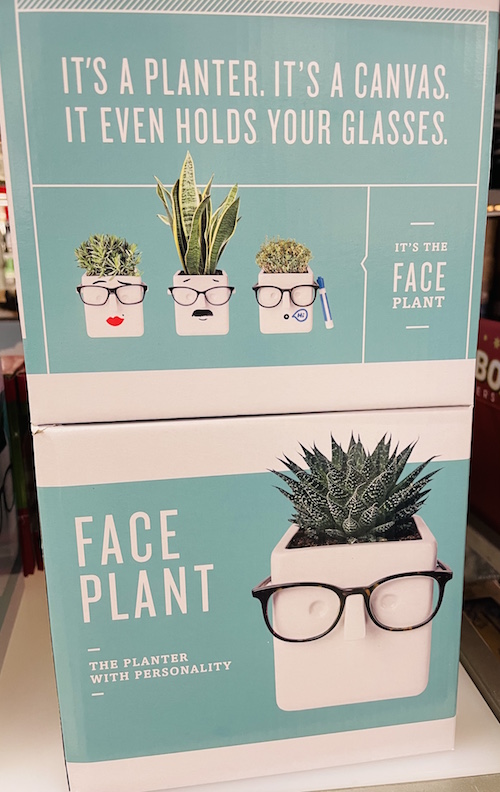
A stop at IKEA in Atlanta was so productive for organizing tools that you’ll be seeing posts with nifty names like Övning (for tidying a child’s desk accessories and creating privacy), Kugsfors (wall-mounted shelves with tablet stands for keeping books and iPads visible while working), Bekant (sit/stand desks) and more.
ORGANIZING YOUR FINANCIAL & LEGAL LIFE
Not everything in the organizing and productivity world is fun to look at, and that’s especially true of all the financial and legal documents that help you sleep soundly at night. Still, Paper Doll kept you aware of how to understand and protect your money, your identity, and your legacy.
Speaking of which, if you haven’t created your Apple Legacy Contact and your Google Inactive Account Manager, why the heck not? Use the power of body doubling up above, grab a partner, and get your digital life in order!
Lost & Found: Recover Unclaimed Money, Property, and Savings Bonds
Paper Doll’s Ultimate Guide to Legally Changing Your Name
Paper Doll Explains Digital Social Legacy Account Management
How to Create Your Apple & Google Legacy Contacts
Paper Doll Explains Your Health Insurance Explanation of Benefits
DEALING WITH EMERGENCIES AND STRESSFUL SITUATIONS
Sometimes, I write a post I wish I’d been able to read earlier (like the one on preventing and recovering from a car theft). Other times, like when a friend had a health emergency, or when Paper Mommy had her fall in November, I’m glad the posts already exist. If you missed these the first time around, please be sure to read, share, and bookmark them; think of them as an insurance policy, and let’s hope you won’t need them.
How to Organize Support for Patients and Families in Need
Organize to Prevent (or Recover From) a Car Theft
Paper Doll Organizes You To Prepare for an Emergency
GRAB BACK OF INTERVIEWS, UPDATES, AND PHILOSOPHY
Paper Doll Interviews Motivational Wordsmith Kara Cutruzzula
You already know how beloved my friend Kara Cutruzzula‘s Brass Ring Daily newsletter and Do It Today podcast are at Paper Doll HQ.
After having read and enjoyed Kara’s Do It For Yourself — A Motivational Journal and her follow-up, Do It Today — A Motivational Journal (Start Before Your Ready), I had no doubt that I’d be jumping on her third when it was released in September.
If you haven’t already picked up Do It Or Don’t — A Boundary-Creating Journal, use that Amazon money you almost certainly got this holiday season!
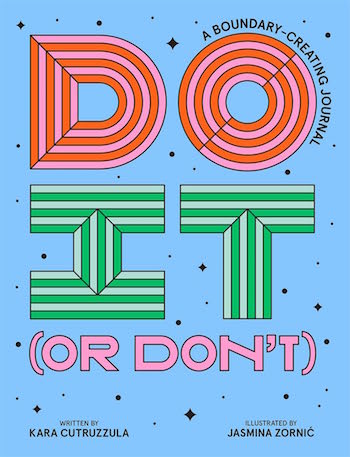 One of the Paper Doll themes for 2024 will focus on setting (and maintaining) better boundaries to accomplish more of what’s meaningful, and I’ve got multi-color tape flags sticking out of Kara’s book from all the chapters to share her bounty with you.
One of the Paper Doll themes for 2024 will focus on setting (and maintaining) better boundaries to accomplish more of what’s meaningful, and I’ve got multi-color tape flags sticking out of Kara’s book from all the chapters to share her bounty with you.
What’s in a Name? “Addressing” Organizing and Productivity
Paper Doll Suggests What to Watch to Get More Organized and Productive — As we head into the new year, I’ll be keeping my eyes open for podcasts, webinars, and TV shows to help you keep your space organized, your time productive, your finances orderly, and your life joyous. Readers have been sending in YouTube and TikTok videos that inspire them, so please feel free to share programming that you’d like to see profiled on Paper Doll‘s pages.
Paper Doll on How to Celebrate Organizing and Productivity with Friends
Paper Doll and Friends Cross an Ocean for Fine Productivity Conversations
From in-person get togethers with frolleagues (what my accountability partner Dr. Melissa Gratias calls those special folks who are both friends and colleagues) to Friday night professional organizer Zooms, accountability calls, and Mastermind group collaborations, this has been a great year for staying connected and sharing the benefits of those conversations with you.
I also loved guesting on so many fun podcasts related to organizing, productivity, technology, and more. If there’s someone you’d like to hear me debate or banter with, let me know!
SEASONAL POSTS
Spooky Clutter: Fears that Keep You from Getting Organized
Paper Doll’s Thanksgiving Week Organizing and Productivity Buffet
Paper Doll De-Stresses Your December
Paper Doll on Clutter-Free Gifts and How to Make Gift Cards Make Sense
Are you stressed out because you haven’t gotten someone a gift yet? Maybe a good start would be to help an overwhelmed special someone take my advice about going on a travel break. Consider gift certificates for something like Get Your Guide, with opportunities to get guided tours of locally-vetted, expertly-curated sporting, nature, cultural, and food experiences. With 118,000 experiences in 150 countries, pick a multiple of $50 or set your own amount, and your recipient can pick the domestic or international travel experience that fits best.
If you know your recipient will be traveling by rail, consider a gift card for Amtrak or ViaRail in North America. Eurail doesn’t sell gift cards, but you can pay for a pass, or buy a gift card for a rail pass for more than a dozen specific European train lines. And if you’d like to help someone organize vacation serenity and secure a bundle of travel attractions for a given city, try TurboPass in Europe or City Pass and The Sightseeing Pass in North America.
HERE’S TO A MORE ORGANIZED AND PRODUCTIVE 2024
Whether you’ll be spending the next few days reading, traveling, or doing your annual review, I hope this last week of 2023 is a happy and healthy one.
To send you off for a cozy week, I’d like to share a Whamagaddon– and Mariah–free, retro 100-minute holiday playlist from the late 1930s through the early 1960s. It’s somehow easier to dismantle the tree and write thank-you notes to Guy Lombardo. (My favorite clocks in at 52:42 with “What Are You Doing New Year’s Eve?”)
Please let me know your favorite Paper Doll posts from this year, and I’ll meet you back here in 2024!
Paper Doll’s Thanksgiving Week Organizing and Productivity Buffet
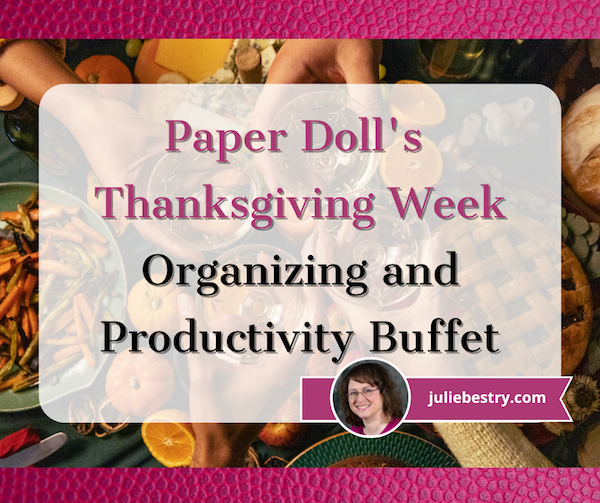
Whether you’re getting ready to go over the river and through the woods, hosting a Thanksgiving celebration of your own, or stuck (in an airport or at home) with too little to do, today’s post is for you.
I’ve created a Thanksgiving buffet from which you can take some tastes and figure out what you like. Decide for yourself whether to categorize any of these as appetizers, entrées, sides, or desserts. There’s nothing serious to require your deep attention, so just nibble as though you were sneaking through the kitchen on your way to watch the parade.
GRATITUDE AND A FOLLOW-UP ON THE CAR THEFT
If you read my August post, Organize to Prevent (or Recover From) a Car Theft, you know that I was a victim of the Kia Boys, young miscreants across the United States who steal KIAs and Hyundais, not for financial gain but for “street cred” or thrills. It’s my philosophy that almost anything bad from which you recover makes a good anecdote (or blog post), but the lesson of preventing car thefts and recovering from them is one I’d have preferred to research online rather than personally experience.
The indignities of being a victim of theft did not stop with the recovery of my little red PaperDollmobile. Due to a turf war between towing companies, miscommunication at the body shop, an utter failure of professionalism on the part of someone we’ll call the Jerky Insurance Dude, and a series of back-ordered parts (mostly due to the mass of Kia and Hyundai thefts nationwide), it took two months for my car to be repaired and returned.

Just a few weeks ago, the federal judge who initially refused to approve the $200 million class action settlement against Kia and Hyundai because it wasn’t supportive enough of victims has acknowledged the revisions to the settlement and approved it. It will likely be years before we victims see those compensatory funds (almost certainly be reduced by attorney and court costs), but the resolution is something else for which I can be thankful.
Meanwhile, if you haven’t read the original post, or if you’d like to hear more of the updates, or if you just prefer a good chatty tale, friend-of-the-blog Dr. Frank Buck recently had me on his podcast in an episode entitled From Chaos to Clarity: A Professional Organizer’s Car Theft Journey.
Frank and I discussed many of the concepts in my blog post, but also expanded upon teh experience. We talked about handling the unexpected, and how to deal with shock of a situation but still capture the essential information in order to survive and get to the other side. Professionally and personally, Frank and I can attest to the essential role of good note taking during any emergency or catastrophe.
If you watch the podcast on video, above, and please leave a comment or “like” on Frank’s YouTube page. Or, if you’re driving somewhere this week and need to drown out the “Are we there yet?” whines punctuated by kicks to the back of your seat, you can listen to my episode of Frank’s podcast on Apple Podcasts, Google Podcasts, Spotify, Overcast, Castbox, and pretty much wherever you get your pumpkin-spiced podcasty goodness.
HOW TO SHOW GRATITUDE FOR OUR BOUNTY
“There is no product or service more ecological, sustainable and recyclable as the one we do not use.”
— Philippe Bihouix, engineer and author of The Age of Low Tech: Towards a Technologically Sustainable Civilization
This quote, included in Sunday’s Cool Tools Lab’s Recommendo newsletter, was certainly well-timed.
What a perfect way to show gratitude for the bounty in your life by using the week ahead to identify what you’re not using or wearing and earmark those items for donation.
Thanksgiving is an ideal time to discuss with your children the concept that not everyone has as much, and help them consider the toys and games they’re no longer enjoying. It’s a great way to be responsible to the planet, their fellow humans, and their own home.
And what better way to teach your children than by example?
Last Friday, I gave one of my signature speeches detailing all the reasons why it’s difficult to let go of possessions. I talk about how we sit on our “Buts” (one T) as in, “I’d let go of it…but it was expensive.” Or, “I’d let go of it, but it was a gift.” In part of that presentation, I noted that one of the big “buts” in letting go of excess is “But I want to find the perfect home before letting go.”

People Working at Donation Center Photo by Gustavo Fring via Pexels
We hate spending the time, money, and effort to keep what we don’t want or need, but we hate the idea of “wasting” perfectly good items more, as if languishing in OUR basement is a better fate for something than ending up with (an unknown) someone whose worth we can’t know or judge.
So, we decide that as soon as we find the perfect place for an unused table to go, we’ll send it on its way, but either we don’t know about available resources (like a furniture bank or Habitat for Humanity’s Restore) or we never go all the way from making the decision to actually getting it out of our homes. Take comfort that whether you recycle, donate, or sell, letting go of what you never use has three benefits. It means a good home for the item, joy for the new owner, and more space for you.
As we say in professional organizing, done is better than perfect!
GET CRAFTY ABOUT REDUCING YOUR CRAFT STASH
Speaking of getting rid of excess for purposes of sustainability, my fabulous friend and colleague Janice Simon of The Clutter Princess brought my attention to a nifty option for all of you crafty (and aspiringly crafty) folks.
Destashify is your resource for letting go of the excess cloth- and needlework-adjacent craft supplies you have on hand. It’s a bit of crafting thrift shop. In their words: Destashify is dedicated to keeping sewing, quilting, knitting, crochet, and other wearable art supplies out of landfills.
Destashify will sell, recycle, or donate your excess crafting supplies to individuals or organizations who will make use of you letting them instead of letting them pile up in the corner.
Obviously, if you actively work on your crafts, nobody would encourage you to stop. But if you have piles of these kinds of supplies, either in your own space or the space of someone you have responsibility for maintaining, Destashify offers a few nifty options.

Destashify, Filtered for Purple Yarn
Sort through your materials and collect any unwanted fabric, patterns, yarn, trim, and notions. If you have books, magazines, or DVDs on sewing, quilting, or related crafts, as well as patterns or even machinery (like sewing machines, accessories, and software), add them to your outgoing stack. Now, you have two options.
Sell Your Craft Supplies via Destashify
If you sew, quilt, knit, or are otherwise a “fiber artist,” you can destash (that is, declutter your stash), start a side hustle to fund your hobbies or life, or expand any craft-related existing business with a new outlet.
- Create a Destashify seller’s account and list your items for sale.
- Fulfill orders made through the Destashify site.
- Receive payment through either Venmo or Paypal.
Destashify charges no up-front costs to sellers. If you sell supplies via Destashify, they keep $1 + 15% of the remaining product subtotal. Beyond that, they charge no extra listing fees or payment transaction fees. If any of your items fail to sell, they won’t charge you anything for the listing (or re-listing). Buyers pay one flat fee for shipping, and sellers retain 100% of the shipping fee, but are responsible for the actual shipping costs.
Donate Your Craft Supplies to Destashify
If you donate your craft supplies, Destashify will pay for the shipping! (Note: Destashify is not a 501(c)(3), so you can’t deduct the value of your donation on your taxes.)
Destashify may donate your donations to organizations, like schools, or sell to fund operations. As when you donate anything, make sure your supplies are in good, clean condition. They can be related to: sewing, quilting, knitting, crochet, weaving, embroidery, tatting, upholstery, and home décor. Gather them up in a box (or boxes) and then:
- Click on the “contact us” link at the bottom of every page of the Destashify page and tell them that you want to donate.
- Once you provide your shipping address and phone number, Destashify will send you prepaid shipping labels (with the information you provide as the label’s return address).
- Include the height, width, and depth dimensions, as well as the weight of each package you want to send. (Limit your shipping box dimensions to under 19 inches.)
They require a minimum of one yard of apparel fabrics or 1/4 yard for quilting fabrics. Leather, suede, and fur are accepted, as is yarn. Notions include doohickeys like thread, elastic, and grommets, while fastenings are, as you might guess, things that let you fasten clothing, like snaps, buttons, or zippers. Destashify will also accept small tools, like rulers, scissors, and awls.
However, they are unable to accept donations that are heavy or oversized, requiring excess storage space or egregious shipping costs. So, please don’t donate big storage or furniture items like cabinets or sewing tables, nor heavy machines like sewing machines or sergers. (You can list them for sale through Destashify, though!)
Watch two of the Destashify-ers talk about craft donation hauls here.
Destashify is a young venture, so they currently only support U.S.-based sellers; they are able to ship to buyers in Canada and the United Kingdom.
Finally, if your craft area is nicely pared down and organized, and you’re interested in buying from Destashify, just click on any menu and use the left-side panel to filter for things like color families, fabric types, fibers, patterns, garments and garment types, weights, and more.
PUT THE KIBOSH ON COAT CLOSET KERFUFFLES
Longtime readers of the blog know that I’m not one for recommending unnecessary products, and I don’t usually mention products that are too far afield from organizing your paper, information, and productivity. And I definitely avoid recommending products before they’re entirely on the market. However, when things come across my TikTok feed that make me sit up and take notice, I want to share them with you.
Swedish inventor and YouTuber Simone Giertz has developed Coat Hingers, and no, that’s not a typo. Giertz’s Kickstarter was seeking $50,000 to manufacture foldable hangers to allow for clutter-free storage in shallow closets and narrow spaces. In the first two days, she not only hit her goal, but exceeded it! Now, with 26 days remaining in her Kickstarter month, she’s already garnered $255,984 in pledges from 1940 backers aspiring to own the product.
Unlike the kind of foldable hangers designed to be used in luggage, Giertz found no solutions for folding hangers meant to actually be hung in closets, particularly shallow ones. So, she created her own, developing prototypes of hinged hangers.
You just put your article of clothing on the hanger, fold at the hinge, and now you’ve got the ability to store the shirt (or whatever) in half the depth.
Whereas traditional hangers measure about 17 1/2 inches, horizontally, Coat Hingers fold to take up just 9.3 horizontal inches. The hingers are made of stainless steel hangers with injection molded acetal hinges for durability.
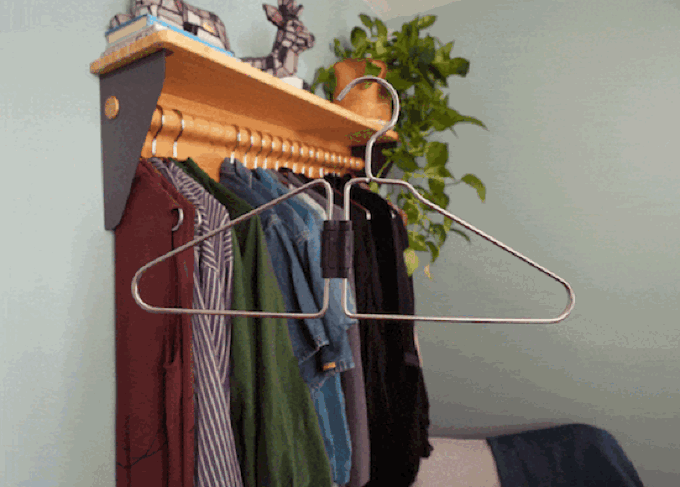
Supporting Giertz at this point is a pricey, but if you’re in a small space and are likely to be there a while, it’s worth considering. One Coat Hinger is $20, and a dozen are $75.
Because Coat Hingers need to be a certain distance from the wall, they recommend that in lieu of off-the-shelf (no pun intended) closet rods, you make the rods in their kits, which come in four different color schemes (charcoal, white, red, and green). The shelf kit is $270, while the small bracket kit is $135 and the large is $200. The shelf kit and large bracket kit come with two dozen Code Hingers; the small bracket kit comes with one dozen.
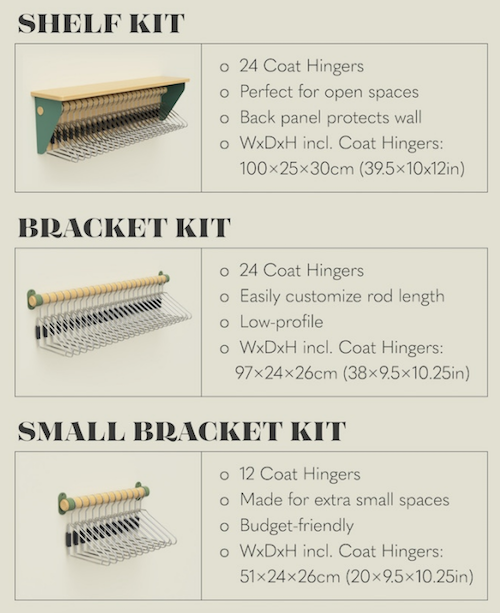
All Coat Hingers come with a set of silicone stoppers that slide along the diagonal arms of the hanger to keep items with low necklines or thin straps from sliding off of the hanger.
Unfortunately, Kickstarter videos aren’t shareable. (Why?! Social sharing would bring in so many more backers?) However, Giertz’s YouTube channel has a great video on how her product came to be that will give you a good sense of what she’s creating.
(Did you notice that it’s pronounced coat hinge-er, accenting the hinge, rather than coat hing-er to sound like hanger?)
When I was in graduate school, I lived with six other students in my program in a scary green Addams Family-esque house with squirrels in the attic. Due to the luck of the draw, I got one of the larger bedrooms, but the closet was minuscule, slightly smaller than a telephone booth, with the sole rod positioned on the diagonal. Hanging clothes in that shallow a space was almost an impossibility, as was keeping any kind of order. I would have loved Coat Hingers back in 1990!
DE-STRESS THE HOLIDAY SEASON FROM THE START
Thanksgiving is the official start of the holiday season, which means it can also be the start of the stressed-out, exhausted season as well. I’ve got two resources for you for keeping your season on an even keel.
First, the theme of Janet Barclay’s November Productivity and Organizing Carnival is Stress-Free Holidays. It includes 15 posts from my fabulous colleagues for helping you deal calmly with planning and organizing your season and getting the self-care you need.
Then, you might want to pick up a copy of my classic season-smoother, Simplify the Season and Save Your Sanity so that you can thrive, and not merely survive during the upcoming holiday season.
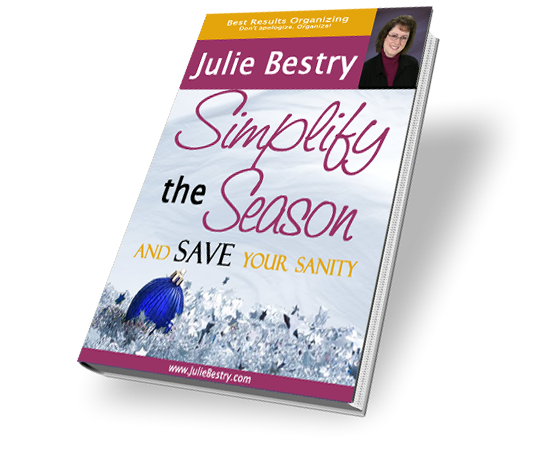
Are you so frazzled by mid-December that your nerves start to feel like tangled Christmas lights?
Have visions of sugarplums been replaced by nightmares of long lines and traffic jams?
Does that Thanksgiving turkey remind you of a time bomb, ticking down to the big day in December?
If so, Simplify the Season and Save Your Sanity may be exactly what you need.
PLAN FOR A SANE RE-ENTRY NEXT WEEK
Heading back to work after a long Thanksgiving weekend can be overwhelming, and it can be tempting to try to barrel your way through the work. However, back in October, we talked about the importance of taking time away from your desk to refresh, whether short-term or long-term.
Take a Break — How Breaks Improve Health and Productivity
Take a Break for Productivity — The International Perspective
After you revisit these posts, you may want to read this piece from The Muse, Take Five: 51 Things to Do When You Need a Break at Work.
I’d explored a variety of break options, but some readers mentioned that they often feel guilty taking breaks that “looked” lazy, as if doing healthy things for your body, brain, and spirit somehow lacked worth. (Remember Paper Doll telling you this: you are not your job or your role. Your worth does not come from what you do. It’s innate to who you are!)
The genius of this Muse post is that it offers some fun suggestions, links, and resources for digging deeply into categories of breaks that still accomplish something, in case you’re still working on accepting yourself even when you’re not entirely in worker-bee mode. The categories are:
- Energizing
- Brain-Boosting
- Social
- Productive (It won’t surprise you that this is my favorite category of tips!)
- Career-building
- Relaxing
- Downright Distracting
My favorite, given that we’ll have just come out of Thanksgiving, is #18:
Send a thank you note to someone who’s helped you out recently—your assistant who’s gone above and beyond or a co-worker who proofread a report for you. It doesn’t even have to be something big—in fact, bonus points if it’s not.
And with that, kind readers, I thank you for reading, commenting, and sharing. May you and your families and friends have safe travels and a happy, healthy Thanksgiving.
Organize to Prevent (or Recover From) a Car Theft
HOW I LEARNED ABOUT “KIA BOYS”
It all started with a voicemail. I heard voices mumbling, and then a teenage girl said, “Hi. I’m just wondering, did you lose a car? Call this number back because, um, we just saw a red Kia, so if you’re missing a red Kia call this number back because we just saw someone drive away with a red Kia.”
I get a lot of robocalls, recorded messages meant to sound like personal calls. On my office line and cell, they want to talk to me about my car warranty or a problem on my “Microsoft computer” or, since the pandemic, let me know my company is due $26,000 per (non-existent) employee for the Employee Retention Tax Credit.
But I have a red Kia Soul, which I just paid off last month. So instead of hitting “delete,” I saved the voicemail (from an hour earlier), grabbed my key fob, and ran outside to my parking space. I clicked, but heard no “whoop whoop.” Repeatedly clicking, I searched left to right, thinking perhaps I’d parked a few spaces away in either direction. No car. No broken glass. Just nothing.
I pinched myself, sure this was one of those dreams, like the one where it’s the end of the school year and you haven’t ever attended class. I called the number back, and began a harrowing day. I learned that at 8:50 a.m., the caller and three fellow homeschooled classmates were walking into the gym associated with a church around the corner, just 0.8 miles away. The car thief, startled by their approach, “got back in the car, hit a fence, and drove off through a field.”
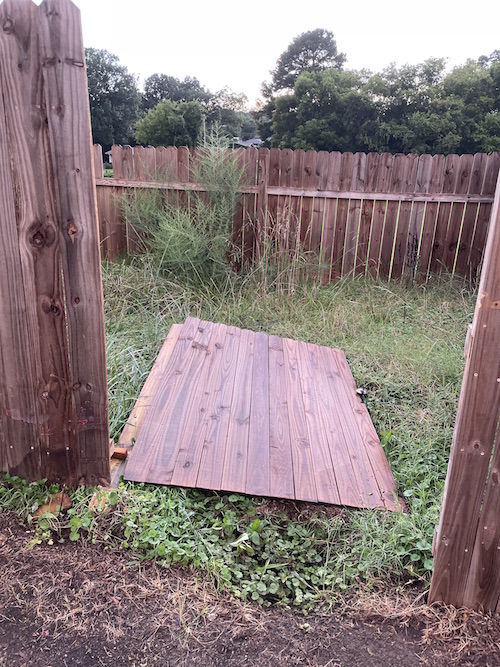
The thief drove my car into the church’s enclosure fence
Unfortunately, they didn’t think to call the police at the time, but after their volleyball practice was over, they came out to find that before they’d interrupted him, the driver had tossed all of my insurance and registration paperwork (as well as, inexplicably, my umbrella and the car parts he’d broken) all over the parking lot and the edge of the field. The girls found my number on the insurance papers and called me at that point.
From there, I called the police. I received a dutiful visit from an officer whose serious demeanor reminded me of Tim from The Rookie.

Next, I spent the afternoon making an insurance claim over the phone, which was made more difficult by a powerful thunder/lightning/hail storm and tornado watch and a four-hour power outage that knocked out my landline.
This was no ring of car thieves. (Kias have the VIN number etched on every engine part, so chop shops don’t want them.) It was, as witnesses and doorbell cameras eventually identified, a teenage boy. Apparently, mine was not an uncommon experience. As I learned from the numerous salt-in-the-wound emails my friends and colleagues sent me, it was an attack by “Kia Boys.” These teenagers learn (from videos propagated across YouTube, Snapchat, and TikTok) how to exploit a flaw in some Kias and Hyundais to start them with just a USB cable, steal them, go joyriding, and abandon the vehicles after a bit of nefarious Ferris Beuler’s Day Off fun.
Kia and Hyundai just settled a $200 million lawsuit which should have meant theft victims like me would be reimbursed for damages, towing and car rental costs, and other out-of-pocket charges racked up as a result of this thievery. There would also have been software upgrades, extended alarms, and stickers to warn off would-be thieves. However, last week, a judge delayed approval of the settlement, saying “it fails to provide “fair and adequate” relief to vehicle owners.”
ORGANIZE TO PREVENT YOUR CAR FROM BEING STOLEN
If being organized guaranteed a car wouldn’t be stolen, professional organizers would be immune. However, there are proactive measures to make your vehicle less vulnerable and deter potential thieves from targeting your car.
- Keep your car in your garage. This recalls the quote, “A ship in harbor is safe, but that is not what ships are built for.” The safest place for your car is in your locked garage rather than in the driveway or on the street. Of course, this means that you might have to reduce the clutter in your garage and organize it to make room for your household’s cars.
- Park in well-lit, well-populated areas, especially at night. This obviously isn’t foolproof, as my car was stolen in broad daylight, at approximately 8:40 a.m., with 40 apartments directly facing my parking space.
- Remove valuables from your car when you’re not in it. Keep a basket or bin in your vehicle or the garage to make it easy to carry things from car-to-home at the end of the day.
- This advice isn’t designed to clutter-shame you, but why tempt thieves who might steal the contents of your car even if they don’t steal your entire car? My car was practically empty; not counting jumper cables in the hatchback/trunk area (which the thief never accessed), the only non-paper items in the interior car were two umbrellas, a $10 phone charger, and my driving eyeglasses.
- The less you have in your car, the easier it is to remember what was stolen and to report it to the police (in case they can track fenced items) and your insurance company.
- If you must leave valuables in the car when you are out and about, hide them to make the contents of the car, if not the car itself, look less desirable. Stash things in the trunk or under the seat, or even in an empty dog food bag or diaper box.

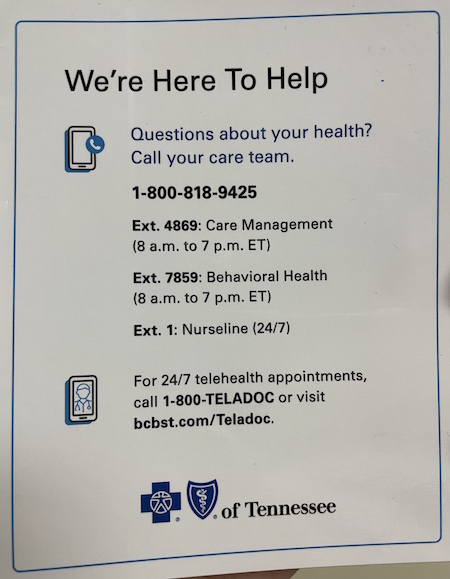

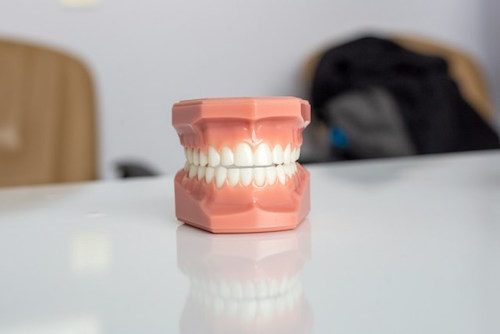

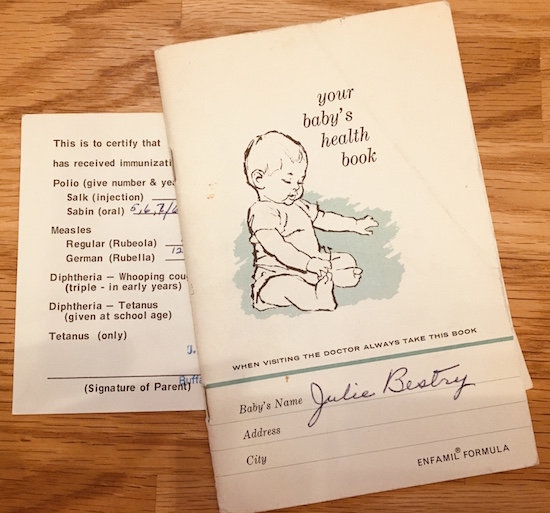

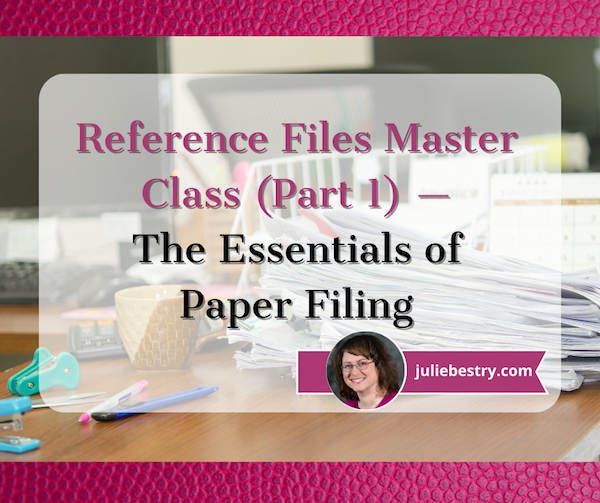

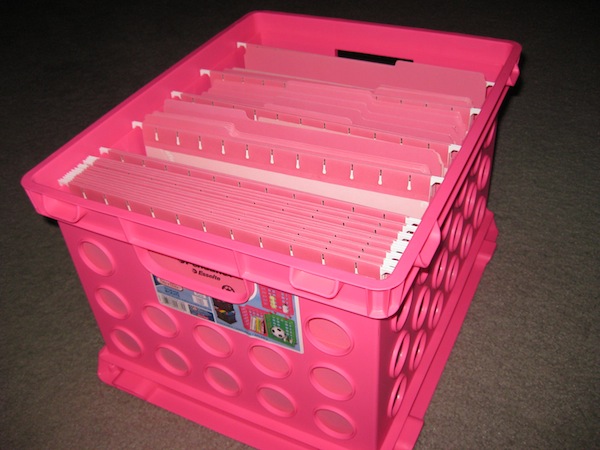



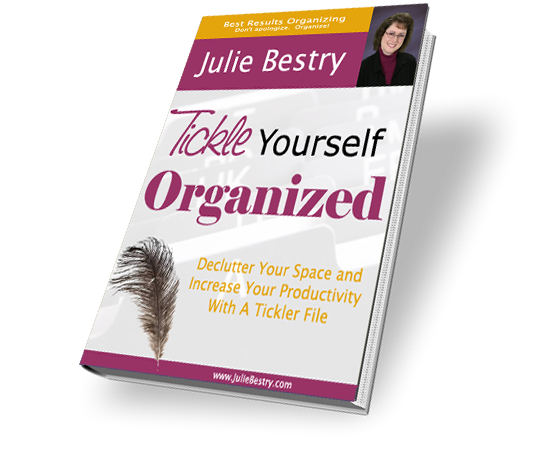












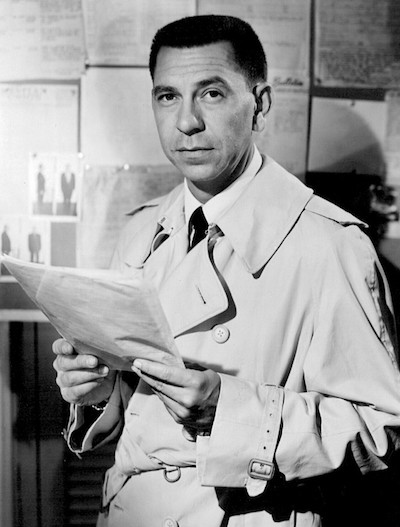
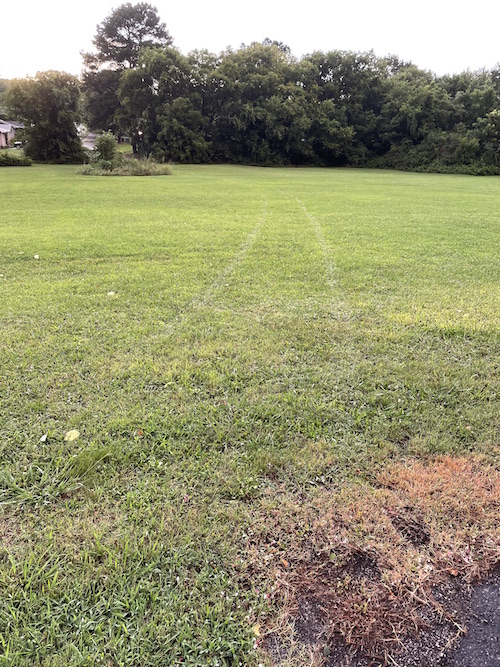
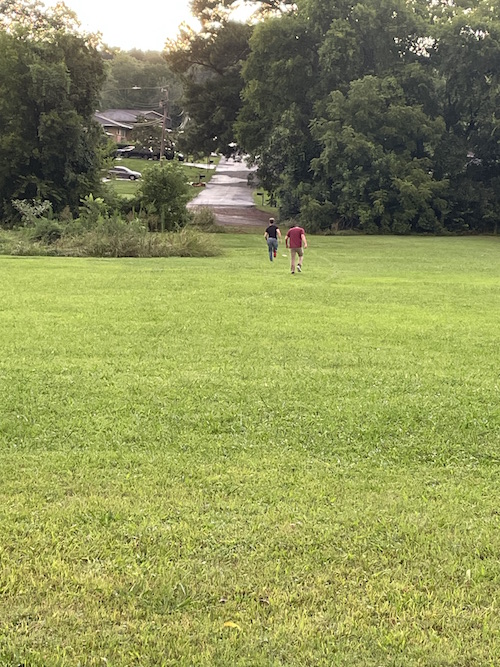

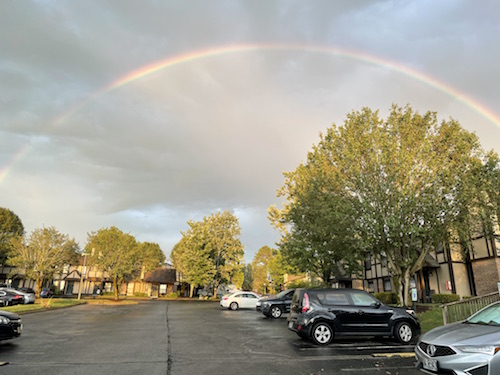



Follow Me